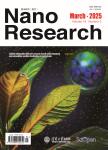Cytotoxicity and non-specific cellular uptake of bare and surface-modified upconversion nanoparticles in human skin cells
Cytotoxicity and non-specific cellular uptake of bare and surface-modified upconversion nanoparticles in human skin cells作者机构:Macquarie University Australia I.M. Sechenov First Moscow State Medical University Russia Shemyakin-Ovchinnikov Institute of Bioorganic Chemistry Russian Academy of Sciences Russia Nizhny Novgorod State University Russia Moscow Institute of Physics and Technology Russia Moscow State University of Fine Chemical Technologies Russia University of Amsterdam the Netherlands
出 版 物:《Nano Research》 (纳米研究(英文版))
年 卷 期:2015年第8卷第5期
页 面:1546-1562页
核心收录:
学科分类:0710[理学-生物学] 081702[工学-化学工艺] 07[理学] 08[工学] 0817[工学-化学工程与技术] 071002[理学-动物学]
基 金:supported by Grant to the Government of the Russian Federation for State support for scientific research under the guidance of leading scientists in Russian educational institutions of higher professional education scientific establishments of the National Academy of Sciences and state research centers of the Russian Federation (Megagrant) (in part of chemical syntheses and surface modification of the UCNPs) Grant of Russian Foundation of Basic Research (in part of cell culture studies)
主 题:nanoparticle upconversion surface modification biocompatibility cytotoxicity human skin
摘 要:The cytotoxicity and non-specific cellular uptake of the most popular composition of upconversion nanoparticle (UCNP), NaYF4:Yb^3+:Er^3+, is reported using normal human skin cells, including dermal fibroblasts and immortalized human epidermal linear keratinocytes (HaCaT). A new hydrophilization reaction of as-synthesized UCNPs based on tetramethylammonium hydroxide (TMAH) enabled evaluation of the intrinsic cytotoxicity of bare UCNPs. The cytotoxicity effects of the UCNP surface-coating and polystyrene host were investigated over the concentration range 62.5-125 μg/mL with 24-h incubation, using a MTT test and optical microscopy. The fibroblast viability was not compromised by UCNPs, whereas the viability of keratinocytes varied from 52% ± 4% to 100% ± 10% than the control group, depending on the surface modification. Bare UCNPs reduced the keratinocyte viability to 76% ± 3%, while exhibiting profound non-specific cellular uptake. Hydrophilic poly(D,L-lactide)- and poly(maleic anhydride-alt-l-octadecene)-coated UCNPs were found to be least cytotoxic among the polymer-coated UCNPs, and were readily internalized by human skin cells. Polystyrene microbeads impregnated with UCNPs remained nontoxic. Surprisingly, no correlation was found between UCNP cytotoxicity and the internalization level in cells, although the latter ranged broadly from 0.03% to 59%, benchmarked against 100% uptake level of TMAH-UCNPs.




